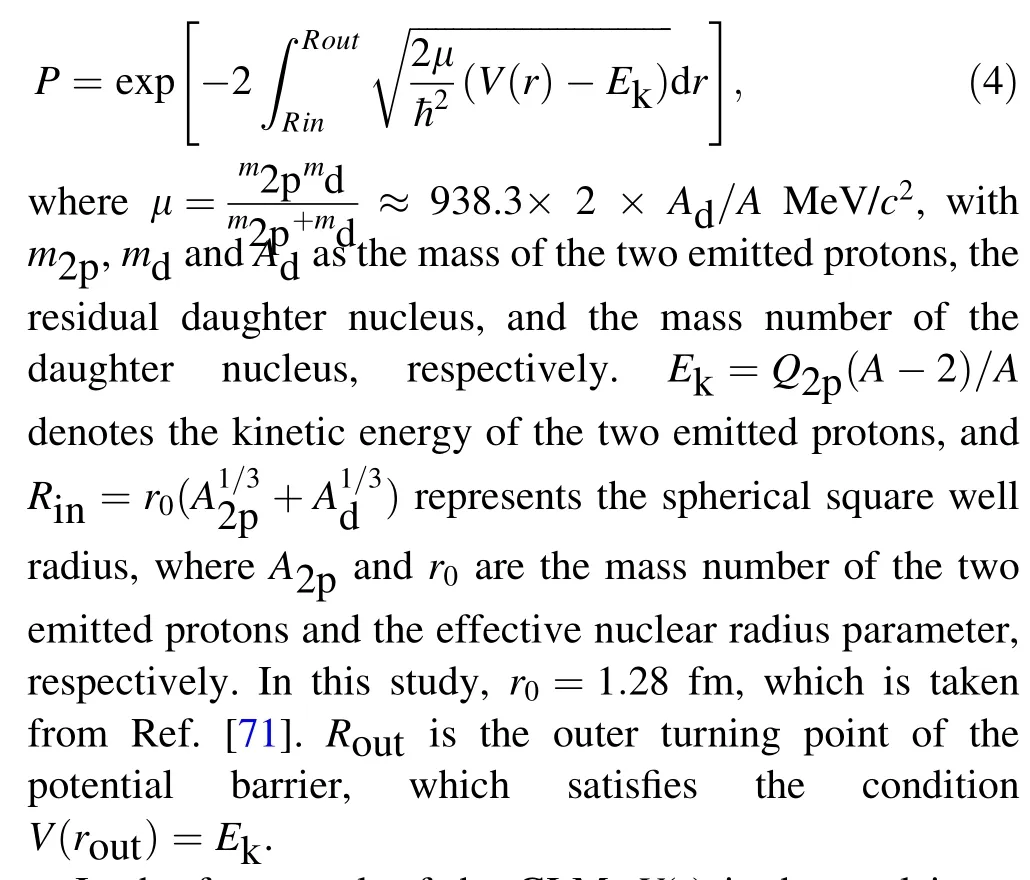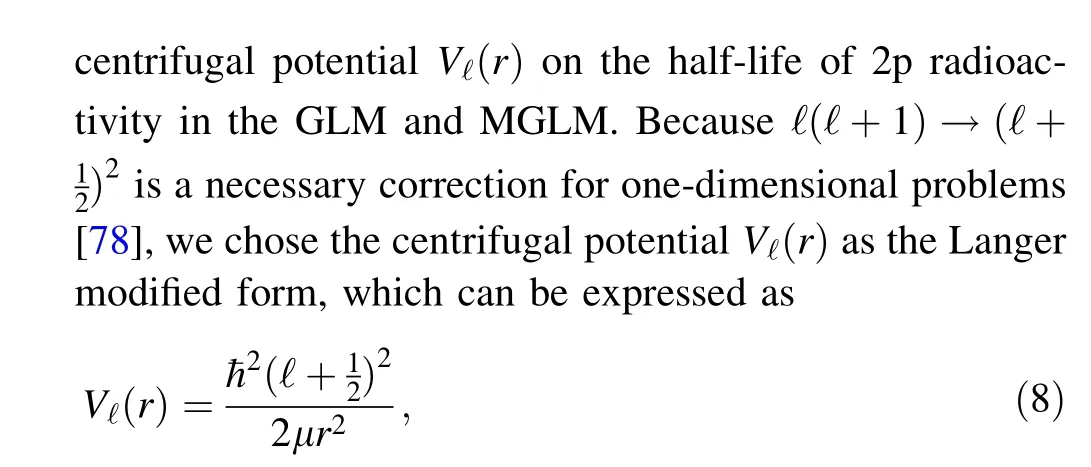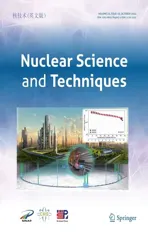Two-proton radioactivity of the excited state within the Gamowlike and modified Gamow-like models
2022-11-21DeXingZhuYangYangXuHongMingLiuXiJunWuBiaoHeXiaoHuaLi
De-Xing Zhu · Yang-Yang Xu · Hong-Ming Liu · Xi-Jun Wu · Biao He ·Xiao-Hua Li,5,6,7
Abstract In this study, we systematically investigated the two-proton (2p) radioactivity half-lives from the excited state of nuclei near the proton drip line within the Gamowlike model (GLM) and modified Gamow-like model(MGLM). The calculated results were highly consistent with the theoretical values obtained using the unified fission model [Chin. Phys. C 45, 124105 (2021)], effective liquid drop model,and generalized liquid drop model[Acta Phys. Sin 71, 062301 (2022)]. Furthermore, utilizing the GLM and MGLM, we predicted the 2p radioactivity halflives from the excited state for some nuclei that are not yet available experimentally.Simultaneously,by analyzing the calculated results from these theoretical models, it was found that the half-lives are strongly dependent on Q2p andℓ.
Keywords 2p radioactivity · Gamow-like model · Halflife · Excited state
1 Introduction
Since the discovery of radioactivity by Becquerel more than 100 years ago, different modes of nuclear decay and reactions have been researched, including alpha decay[1–3], beta decay [4], fragmentation reactions [5, 6], and heavy-ion collisions [7–10]. In recent years, research on exotic decay around the proton drip line has attracted considerable attention. It is mainly investigated using proton and two-proton (2p) radioactivity processes[11–18], and the latter has been proposed as an extremely exotic decay mode for proton-rich nuclei far from the valley of beta stability. In 1960, Zel’dovich [19] reported that a pair of protons may be emitted from radioactive proton-rich nuclei. Subsequently, Goldansky and Ja¨necke attempted to determine candidates for 2p radioactivity,and Goldansky also coined the term‘two-proton radioactivity.’However,it was Galitsky and Cheltsov[20]who conducted the first theoretical attempt to describe the process of 2p radioactivity. Moreover, studying 2p radioactivity can extract abundant nuclear structure information, such as the sequences of particle energies, the wave function of two emitted protons,spin and parity,and the deformation effect[21–23]. More than 40 years after its theoretical proposal,the long-lived phenomenon of the decay of 2p radioactivity from the ground state to the ground state was first discovered, namely45Fe at GSI [24] and GANIL [25]. Subsequently, a series of the same phenomena was also detected, such as54Zn [26, 27],19Mg [28], and94Ag[29–32].
In addition,short-lived radioactive nuclei processing the excited state can also produce the 2p phenomenon.Ja¨necke was the first to discuss β-delayed 2p (β2p) emission [33].In 1983, the β2p radioactivity of22Al was observed at the Lawrence Berkeley National Laboratory(LBL)for the first time [34], followed by further β2p emitters, such as23Si[35],26P[36],27S[37],and50Ni[38].For 2p radioactivity from the excited state, except for β2p radioactivity, some 2p emitters may be fed by nuclear reactions, such as pickup, transfer, or fragmentation, for example,14O [39],17,18Ne [40–44],22Mg [45, 46], and28,29S [47, 48]. The lifetimes of the excited 2p emissions are extremely short,approximately 10-21s, which is significantly shorter than the lifetimes of the ground-state 2p radioactivity originally predicted by the theory.
From a theoretical point of view, during the last decades, several approaches have been applied to describe the emission mechanism and determine the typical half-life of 2p radioactivity. Whether the two protons emitted in this decay process are related to energy and angle is a question that has attracted attention for a long time.In general,there are three different mechanisms by which proton-rich nuclei emit two protons: (i) sequential emission, where two protons are successively emitted from the parent nucleus, and there is no relationship between them; (ii) three-body simultaneous emission, where two protons are emitted from the parent nucleus simultaneously,and the correlation is weak;and(iii)diproton emission(also called2He cluster emission). The cluster emission of2He is an extreme case with the emission of two strongly correlated protons that can only exist for a short period of time and then separate after penetrating the Coulomb barrier. The three-body simultaneous emission model treats radioactivity as a process in which the parent nucleus contains two protons and a remnant core.
To date,a number of models and/or formulae have been proposed to handle the 2p radioactivity of the ground state[49–62]. In particular, the Gamow-like model (GLM) was proposed in 2013 by Zdeb et al. as a single-parameter model based on Wentzel–Kramers–Brillouin (WKB) theory to study α decay and cluster radioactivity [63]. Subsequently, the GLM proved to be successful in investigating the proton radioactivity and 2p radioactivity of the ground state [64, 65]. Considering that two emitted protons form a2He cluster, the GLM assumed that the 2p radioactivity is due to the quantum mechanical tunneling of a charged two-proton particle through the nuclear Coulomb barrier. Under the assumption of a uniform charge distribution, the inner potential of the GLM is expressed as a square potential well,and the outer potential defaults to the Coulomb potential. As a result of the inhomogeneous charge distribution in the nucleus, superposition of the emitted particles, etc., the electrostatic shielding effect should be considered in the outer potential. Based on our previous studies,in which an exponential-type electrostatic potential, that is, the Hulthe´n potential, was introduced to describe the outer potential, Liu et al. modified the Gamow-like model,denoted as the MGLM,to calculate the half-lives of 2p radioactivity from the ground state [66].The MGLM shows that the theoretical half-lives are in good agreement with the experimental data. It is certainly interesting to examine whether the GLM and its modified version can be extended to study the 2p radioactivity of the excited state. To this end, in the present study, we systematically analyzed the half-lives of 2p radioactive nuclei close to the proton drip line using the GLM and MGLM.The theoretical values were shown to be compatible with those of equivalent experiments.
The remainder of this paper is organized as follows: In Sect. 2, the theoretical frameworks of the GLM and MGLM are briefly presented. Detailed results and discussion are presented in Sect.3.Finally,a summary is given in Sect. 4.
2 Theoretical framework
The 2p radioactivity half-life is typically calculated using

where λ denotes the decay constant.It can be expressed as

where ν denotes the assault frequency associated with the harmonic oscillation frequency in the Nilsson potential[67]. It can be expressed as

where h,¯h,A,and ω are the Planck constant,reduced Plank constant, mass number of the parent nucleus, and angular frequency, respectively. S2p =G2[A/(A-2)]2nχ2represents the preformation probability of the two emitted protons in the parent nucleus, which is obtained using the cluster overlap approximation with G2=(2n)!/[22n(n!)2][68, 69]. Here, n ≈(3Z)1/3-1 is the average principal proton oscillator quantum number, and χ2is the proton overlap function related to Ref. [70].
P is the Gamow penetration probability through the barrier, which can be calculated using the WKB approximation. It can be expressed as

In the framework of the GLM, V(r) is the total interaction potential between the two emitted protons and daughter nucleus, a square potential well represents the inner nuclear interaction potential, and a Coulomb potential, VC(r), is defaulted to represent the outer electrostatic potential. It can be expressed as

where V0denotes the depth of the potential well.Based on Blendowske et al. [72], we chose V0=25A2p MeV.VC(r)=Z2pZde2/r, where Z2p and Zd are the proton numbers of the two emitted protons and daughter nucleus,respectively, and r is the mass center distance between the two emitted protons and daughter nucleus.
To consider the electrostatic shielding effect, in the MGLM, we introduced an exponential-type electrostatic potential known as the Hulthe´n potential VH(r),which has been widely applied in the fields of atomic,molecular,and solid-state physics [73–77], to replace VC(r) for 2p radioactivity from the ground state. To display the difference between VH(r)and VC(r),we plotted a sketch of the total interaction potential between the two emitted protons and daughter nucleus versus the center-of-mass distance of the decay system in Fig.1.From this figure,we can see that VH(r) has the same behavior as VC(r) within Rin but drops quickly when r ≫0. Namely, the total interaction potential V(r) between the two emitted protons and daughter nucleus changes as follows:

where a =1.808×10-3fm-1denotes the screening parameter related to Ref. [66]. This can be used to determine the range of the potential,that is,the shortening of the exit radius. Additionally, we consider the effect of the

Fig. 1 (color online) Sketch map of the total interaction potential between the two emitted protons and daughter nucleus versus the center-of-mass distance of the decay system for 14O*. The external part of the potential barriers is represented by the Coulomb and Hulthe´n potentials

Table 1 Comparison between the experimental 2p radioactivity half-lives of the excited state and those from different theoretical models

Fig. 2 (color online)Comparing the nuclear halflives obtained using the Gamow-like and modified Gamow-like models shown in Table 1 with those of other theoretical models

where ℓ is the orbital angular momentum removed by the two emitted protons, which is calculated by parity and angular momentum conservation laws.
3 Results and discussion
Based on our previous study[65,66],the main intention of this study is to extend the GLM and MGLM to the 2p radioactivity of the excited state. The selected two-proton emitters from the excited state were those with known experimentally released energies, which are both available and considerable.In this study,we calculated the half-lives of 2p radioactivity for14O*,17Ne*,18Ne*,22Mg*,29S*,and94Ag*(*represents the excited state), and the results are listed in Table 1. The experimental data and theoretical results from the unified fission model(UFM)[79],effective liquid drop model (ELDM), and generalized liquid drop model(GLDM)[80]are also listed in this table.In Table 1,the first column represents the 2p decay process, and the second column represents the spin and parity of the initial and final states of the nucleus.The third column represents the angular momentum removed by the emitted two protons, which obeys spin-parity conservation laws, and the fourth column shows the experimental two-proton released energy, denoted as Q2p. The sixth to tenth columns represent the logarithmic forms of 2p half-lives obtained using the GLM, MGLM, ELDM, GLDM, and UFM, respectively. In general, from this table, it is clear that the theoretical half-lives obtained using the GLM and MGLM are highly consistent with those of other theoretical models. Moreover, it is clear that the half-lives are sensitive to the released energy Q2p and angular momentum ℓ.
To intuitively understand the effect of ℓ and Q2p on the half-lives of 2p radioactivity from the excited state, we selected the nuclei14O*and94Ag*to analyze the contribution of ℓ and Q2p to the corresponding theoretical halflives. As shown in Table 1, the half-lives of14O*determined using both the GLM and MGLM differed by nearly three magnitudes for the same ℓ value but different released energy Q2p values(Q2p=1.20 MeV and Q2p=3.15 MeV,respectively).In addition,for94Ag*,the half-lives obtained using the GLM and MGLM with identical Q2p and different ℓ differed by three magnitudes, whereas ℓ varied from 6 to 10. It is clear that either Q2p or ℓ makes a nonnegligible contribution to14O*and94Ag*for their corresponding theoretical half-lives within the GLM, MGLM,ELDM, and GLDM. In fact, the half-lives of 2p radioactivity are highly sensitive to proton-proton interactions owing to the pairing effect of valence protons.Most proton emitters considered in this study are deformed,and in some cases (for example,67Kr), both shape and structural changes occur [23, 70]. The most remarkable effect of the deformed nuclear structure on proton-proton correlations is back-to-back emission, in which protons are emitted from opposite sides of the parent nucleus, yet still have strongly linked energies. The quasi-classical2He model cannot account for the experimentally observed proton-proton correlations, which indicate back-to-back proton emission.Moreover, to illustrate the agreement of the half-lives of the 2p radioactivity of the excited state, which was calculated using the GLM and MGLM,the theoretical results are shown in Fig. 2. It is evident from this figure that the calculated results are highly consistent with those of other theoretical models.


Fig. 3 (color online) Linear relationship between the quantity [log10T1/2 +26.832]/(+ℓ0.25) and based on the empirical formula inRef.[71]classified with ℓ.The blue circle and orange square represent the calculated results obtained using the GLM and MGLM,respectively

Fig. 4 (color online) Linear relationship between the quantity[log10T1/2 +26.832]/(+ℓ0.25) and based on the empirical formula in Ref. [71] as ℓ for 22Mg* is modified as 1 and 2. The blue circle and orange square represent the calculated results obtained using the GLM and MGLM, respectively
4 Summary
In this study, we extended the GLM and MGLM to study the excited state 2p radioactivity of14O*,17Ne*,18Ne*,22Mg*,29S*, and94Ag*for the first time. The theoretical values obtained using the GLM and MGLM were found to be highly consistent with the corresponding experimental and theoretical values from the ELDM,GLDM, and UFM. Simultaneously, it was found that the half-lives of 2p radioactive nuclei decaying from the excited state are strongly correlated with nuclear structure information, such as deformation, Q2p, and ℓ. Compared with the theoretical results from the ELDM, GLDM, and UFM, the half-lives of the excited state 2p radioactivity from the GLM and MGLM are reliable, which provides a positive guideline for future experiments.
Author ContributionsAll authors contributed to the study conception and design. Material preparation, data collection and analysis were performed by De-Xing Zhu, Yang-Yang Xu, Hong-Ming Liu,Xi-Jun Wu, Biao He and Xiao-Hua Li. The first draft of the manuscript was written by De-Xing Zhu, and all authors commented on previous versions of the manuscript. All authors read and approved the final manuscript.
杂志排行
Nuclear Science and Techniques的其它文章
- Thermal hydraulic characteristics of helical coil once-through steam generator under ocean conditions
- Lifetime estimation of IGBT module using square-wave loss discretization and power cycling test
- Optimization of the cavity beam-position monitor system for the Shanghai soft X-ray free-electron laser user facility
- A beam range monitor based on scintillator and multi-pixel photon counter arrays for heavy ions therapy
- Research on manufacture technology of spherical fuel elements by dry-bag isostatic pressing
- Beam–beam effects and mitigation in a future proton–proton collider
